Scottish Crime and Justice Survey 2014/15: Main Findings
Main findings from the Scottish Crime and Justice Survey 2014/15.
3. Bringing Together Crime Statistics
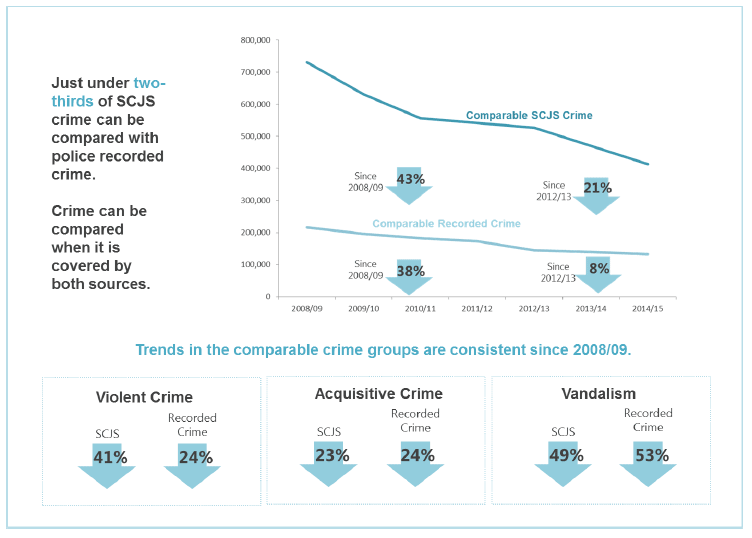
3.1. Introduction
The Scottish Crime and Justice Survey (SCJS) and Police Recorded Crime are essential, complementary sources that, together, present a fuller picture of crime in Scotland. Crimes recorded by the police are important because they can help to evaluate measures in place to reduce crime, assess the performance of policing and criminal justice organisations in Scotland, and also allow them to use evidence to adequately target resources. However, not all crimes come to the attention of the police. Therefore, crime surveys allow a fuller assessment of the overall level and risk of crime. Crime recording is sensitive to changes in public reporting practices, police recording practices and, in part, police deployment and activity. The impact of these, and other effects, contributes to a difference between police recorded crime statistics and crime survey estimates.
This chapter compares police recorded crime statistics to the results of the SCJS to help assess the scale of the difference between the volume of crime that is recorded by the police, and the level of crime that is estimated by the survey to be experienced by the adult population in Scottish households. The analysis in this Chapter builds on an analytical paper, published in 2014, that uses a comparable subset of crime to compare SCJS estimates with police recorded crime figures. It should be noted that this subset of comparable crimes has been created to enable the comparisons between the sources and should not be used to assess the overall level of crime in Scotland.
3.2. Making Comparisons between Recorded Crime and the SCJS
The SCJS and Police Recorded Crime cover different crime and offence groups, different populations and different timescales. They each feature relative strengths and limitations, making them more appropriate in different contexts and for different purposes. Table 3.1 provides an overview of the main differences to bear in mind when making comparisons between the two sources.
Table 3.1: Comparing Recorded Crime and SCJS
| Recorded Crime | Scottish Crime and Justice Survey | |
|---|---|---|
| Where do the data come from? | Administrative police records | Face-to-face interviews with adult residents (16 and over) from a nationally representative sample of the household population |
| Frequency | Collected by financial year. Statistics released in an annual publication. | Survey conducted over 12 months, with recall period extending over 23 months. Results published biennially. |
| Strengths | Covers the full range of crimes and offences. | Captures information about crimes that are not reported to the police (including sensitive issues such as domestic abuse or drug abuse). |
| Provides data at a local level. | Provides information on multiple and repeat victimisation (up to 5 incidents in a series). | |
| A good measure of rarer, more serious crimes that are well reported. | Good measure of trends since 2008/09. | |
| Measure of long-term trends | Analyses risk for different demographic groups and victim-offender relationships. | |
| Good measure of crime that the police are faced with | Provides attitudinal data (e.g. fear of crime or attitudes towards the justice system). | |
| Limitations | Partially reliant on the public reporting crime. | Does not cover all crimes (e.g. homicide or 'victimless' crimes such as speeding). |
| Reporting rates may vary by the type of crime (e.g. serious crime is more likely to be reported, or housebreaking if a crime number is required for insurance purposes) | Does not cover the entire population (e.g. children, homeless people or people living in communal accommodation). | |
| Trends can be affected by factors such as legislation, public reporting practices and police recording practices. | Unable to produce robust data at lower level geographies. | |
| Difficult to measure trends between survey sweeps in rarer forms of crime (such as more serious offences). | ||
| Estimates are subject to a degree of error. | ||
| What other data are collected? | Additional statistical bulletins published on homicides, racist incidents, firearm offences and domestic abuse incidents. | Public perceptions about crime |
| Worry about crime and the perceived likelihood of being a victim. | ||
| Confidence in the police and wider justice system. | ||
| Prevalence estimated on 'sensitive' topics (partner abuse, sexual victimisation, stalking and drug use). |
Taking account of these differences, comparisons between recorded crime and SCJS data can be made by examining a broadly comparable subset of crimes which are covered by each source, and can be coded in the survey in approximately the same way as they would be recorded by the police[10]. Comparisons are made in three broad crime groups: vandalism, acquisitive crime and violent crime[11].
3.3. Overall Number of Crimes - the SCJS and Police Recorded Crime
Of the 688,000 crimes estimated by the 2014/15 SCJS, just under two-thirds (414,000) can be compared with police recorded crimes. In 2014/15, the police recorded 133,170 crimes and offences in the comparable subset. SCJS estimates are higher than recorded crime figures, even in the comparable category, because the survey is able to capture crime that does not come to the attention of the police, and is therefore not covered in recorded crime statistics.
Figure 3.1 Recorded crime and SCJS estimates in the 'comparable crime' category, 1992 to 2014/5
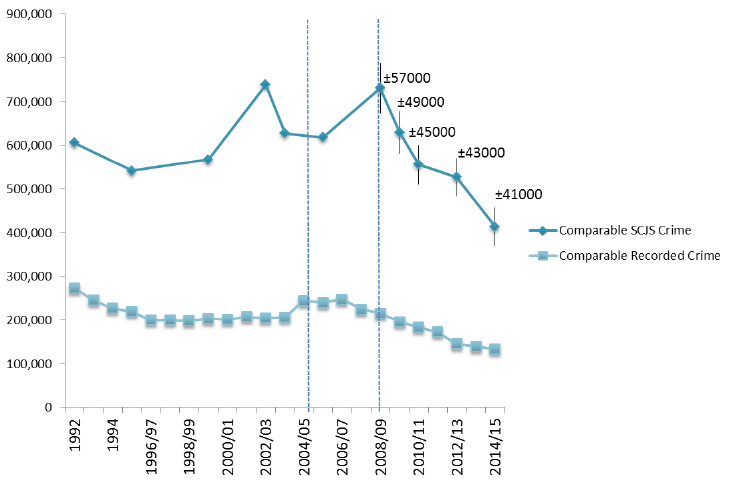
Sources: SCS, SCVS. SCJS[12], Police recorded crime.
Note: The police recorded crime recording period moved from calendar year to financial year after 1994; the SCRS was introduced in April, 2004; the survey moved to the current SCJS design in 2008-09.
Figure 3.1 presents the estimated comparable crime levels for surveys conducted since the 1990s alongside comparable police recorded crime. Figure 3.1 shows the scale of the difference between the crime recorded by the police, and that estimated by the survey in the comparable category. There are a range of reasons for this difference, however the main factor is that the SCJS captures crimes that do not come to the attention of the police, and therefore are not included in recorded crime figures. Chapter 6 provides more information on the proportion of crime that the SCJS estimates came to the attention of the police, as well as providing the reasons that respondents gave for deciding not to report crime to the police.
As discussed in Chapter 2, prior to the establishment of the current SCJS methodology in 2008/09, crime survey estimates in Scotland were derived from smaller samples and the approach to defining the survey reference period varied. As such, estimates were generally subject to a higher level of uncertainty. We have assessed that the greater levels of certainty around survey estimates since 2008/09 enable more consistency in comparisons between the SCJS and recorded crime series. Therefore, the analysis in this Chapter focuses on comparing recorded crime figures and SCJS estimates since 2008/09.
3.4. Trends in the Comparable Crime Group
Table 3.2 Comparable crime group estimates (SCJS 2008/09 to 2014/15)
| 2008/09 | 2009/10 | 2010/11 | 2012/13 | 2014/15 | % change 2008/09 - 2014/15 | % change 2012/13 - 2014/15 | |||
|---|---|---|---|---|---|---|---|---|---|
| Comparable SCJS Crime | 731,000 | 630,000 | 556,000 | 527,000 | 414,000 | -43% | * | -21% | * |
| Comparable Recorded Crime | 216,000 | 196,000 | 183,000 | 145,000 | 133,000 | -38% | -8% | ||
| SCJS Acquistive Crime | 64,000 | 61,000 | 61,000 | 73,000 | 49,000 | -23% | * | -32% | * |
| Recorded Acquisitve Crime | 28,000 | 26,000 | 26,000 | 22,000 | 21,000 | -24% | -4% | ||
| SCJS Violent Crime | 317,000 | 266,000 | 220,000 | 236,000 | 186,000 | -41% | * | -21% | |
| Recorded Violent Crime | 83,000 | 80,000 | 78,000 | 66,000 | 63,000 | -24% | -5% | ||
| SCJS Vandalism | 350,000 | 303,000 | 275,000 | 219,000 | 179,000 | -49% | * | -18% | * |
| Recorded Vandalism | 106,000 | 90,000 | 78,000 | 57,000 | 50,000 | -53% | -13% |
SCJS changes which are statistically significant at the 95% level are highlighted with an '*'.
Base: 2008/09 (16,000); 2009/10 (16,040), 2010/11 (13,010); 2012/13 (12,050); 2014/15 (11,470)
As Table 3.1 indicates, there is greater consistency in the changes over the longer term, with both recorded crime figures and SCJS estimates in the comparable category showing downward trends in the extent of crime between 2008/09 and 2014/15 (-38% and -43% respectively). The 43% fall in crime in SCJS comparable crime between 2008/09 and 2014/15 is statistically significant.
The estimated number of crimes in the comparable subset 2014/15 has fallen by around a fifth (21%) since 2012/13. In comparison, between 2012/13 and 2014/15, recorded crime figures have fallen by 8%, potentially meaning that comparatively more crime has been recorded by the police. Her Majesty's Inspectorate of Constabulary in Scotland (HMICS)'s auditing of incidents and crimes recorded by Police Scotland indicates that police compliance in recording is generally good overall.
The sections below discuss the changes over time in each of the three crime groups.
3.4.1. Acquisitive Crime
The acquisitive comparable crime group includes bicycle theft, housebreaking and theft of a motor vehicle. In 2014/15, the SCJS estimated that there were 49,000 acquisitive crimes (+/- 8,000, meaning that the true number of acquisitive crimes in the underlying population is estimated to be between 41,000 and 57,000). The police recorded 21,000 acquisitive crimes in 2014/15.
Figure 3.2 Recorded crime and SCJS estimates in the acquisitive crime category, 2008/09 to 2014/15
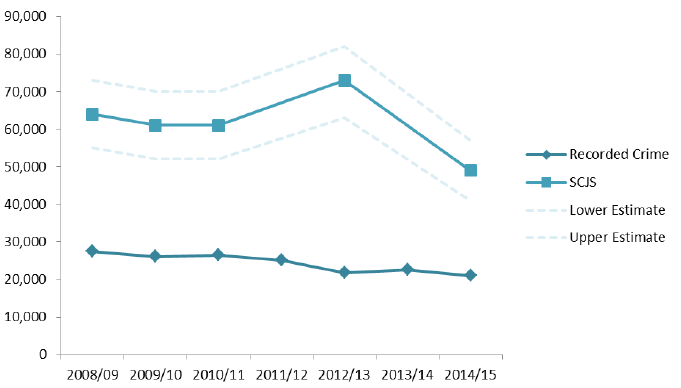
Sources: SCJS, Police recorded crime.
Figure 3.2 shows the trends in SCJS estimates of acquisitive crime in the comparable crime category (2008/09 to 2014/15). With the exception of the SCJS estimate for 2012/13, there has been relative consistency in the trends of both SCJS estimates and police recorded crime figures and trends between 2008/09 and 2014/15. However, it should be noted that the apparent change in the SCJS estimate between 2010/11 and 2012/13 is not statistically significant.
There is greater consistency in the changes over the longer term; between 2008/09 and 2014/15, recorded acquisitive crime decreased by 24%, while SCJS estimates decreased by 23%, a statistically significant change (Table 3.2). Since 2012/13, recorded acquisitive crime has decreased by 4%, while the SCJS has decreased by 33%, a statistically significant change.
3.4.2. Violent Crime
The violent comparable crime group includes serious assault, minor assault and robbery. In 2014/15, the SCJS estimated that there were 186,000 violent crimes (+/- 35,000, meaning that the true number of violent crimes in the underlying population is estimated to be between 150,000 and 221,000), while the police recorded 62,578 violent crimes.
Figure 3.3 Recorded crime and SCJS estimates in the violent crime category, 2008/09 to 2014/15
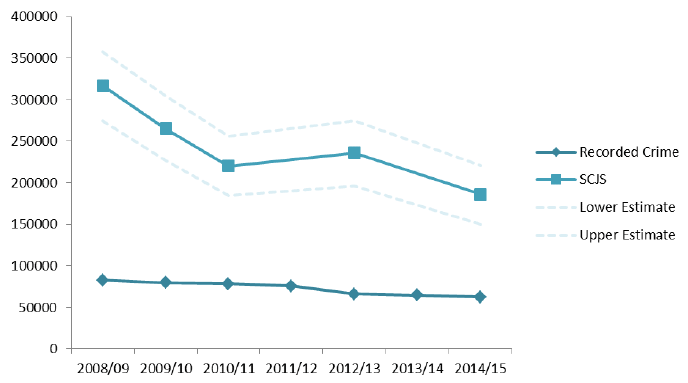
Sources: SCJS, Police recorded crime.
Figure 3.3 shows the trends in SCJS estimates of violent crime in the comparable crime category (2008/09 to 2014/15). There has been relative consistency in the trends for both SCJS estimates and police recorded crime figures between 2008/09 and 2014/15.
Table 3.2 shows that there is greater certainty around cumulative changes in SCJS violent crime estimates in the longer term. Between 2008/09 and 2014/15, both SCJS estimates and recorded crime violent crime figures have shown a decrease (by 41% and 24% respectively). Violent crime estimates are based on a relatively small number of respondents (282 in the 2014/15 survey) who had disclosed experiences of violent crime in the survey.
Since 2012/13, recorded violent crime has decreased by 5%, while the SCJS has shown no change in violent crime estimates since 2012/13 (the apparent 21% decrease was not statistically significant).
3.4.3. Vandalism
Figure 3.4 Recorded crime and SCJS estimates in the vandalism category, 2008/09 to 2014/15
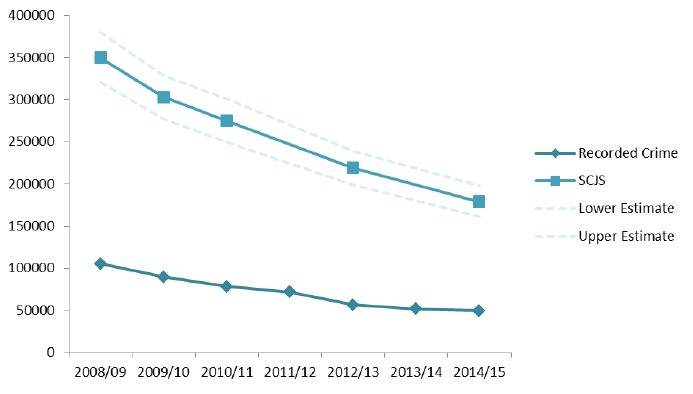
Sources: SCJS, Police recorded crime.
The vandalism comparable crime group includes motor vehicle vandalism and property vandalism. In 2014/15, the SCJS estimated that there were 179,000 instances of vandalism (+/- 18,000, meaning that the true number of acquisitive crimes in the underlying population is estimated to be between 161,000 and 198,000). The police recorded 49,592 vandalism incidents in 2014/15.
Figure 3.4 shows the trends in SCJS estimates of vandalism in the comparable crime category (2008/09 to 2014/15). There has been relative consistency in the trends of both SCJS estimates and police recorded crime figures between 2008/09 and 2014/15.
Since 2012/13, SCJS estimates of vandalism have decreased by 18%, while crimes of vandalism recorded by the police have decreased by 13%. Likewise, over the longer term, both SCJS estimates and recorded crime figures have been on a downward trend since 2008/09 (by 49% and 53% respectively). As Table 3.2 highlights, both these changes in survey estimates are statistically significant.
Compared to the violent crime and acquisitive crime groups, vandalism estimates are based on larger samples of respondents (598 in 2014/15). Consequently, the associated increased certainty around changes in the vandalism subgroup mean that there is greater evidence upon which to make comparisons between trends in recorded crime figures and SCJS estimates.
3.5. Reporting to the Police
SCJS respondents are asked whether the police 'came to know about' the crime, either from them or somebody else. This allows comparisons to be made between crime estimated to have been reported to the police in the SCJS, and police recorded crime figures. Although it is not possible to determine on an individual basis whether a crime that the police 'came to know about' was captured in police recorded crime data, this type of analysis can give an indication of the level of crime that goes unreported, and the broad relationship between police recorded crime figures and SCJS estimates. Making this comparison offers a way of assessing the relationship between the SCJS and police recorded crime data.
3.5.1. Comparing Police Recorded Crime to the SCJS
Figure 3.5 Recorded crime, estimated unreported crime and estimated crime not recorded, in the set of comparable crimes, 2008/09 to 2014/15
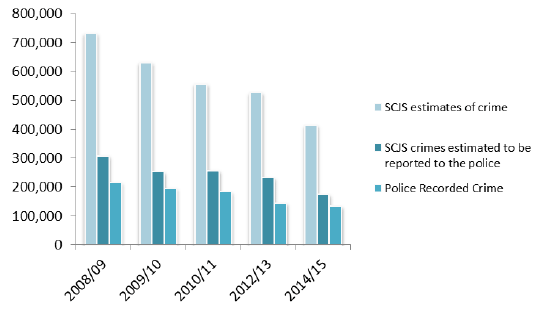
Sources: SCJS, Police recorded crime.
Figure 3.5 presents the estimated level of 'reported' and 'unreported' crime in the comparable crime category across all sweeps of the SCJS, as well as the number of comparable crimes recorded by the police. 'Unreported' crime refers to the crime that is not reported to the police, either by the victim, or by someone else. Figures from the 2014/15 SCJS indicate that of the 414,000 crimes in the overall comparable subset, around 174,000 incidents (42%) were estimated to have been reported to police. In 2014/15, the police recorded 133,170 crimes in the comparable category.
Using this information, it can be estimated that around 32% of the total comparable crimes estimated by the SCJS (that is crime estimated to be reported as well as unreported crime) were recorded by the police in 2014/15. This is similar to the equivalent proportions in recent years (30% in 2008/09, 31% in 2009/10, 33% in 2010/11 and 27% in 2012/13). In addition, as a proportion of all SCJS comparable crimes, the number of comparable crimes estimated to have been reported to the police, and not recorded in police statistics, has been broadly consistent, with the exception of 2012/13; 12% in 2008/09, 9% in 2009/10, 13% in 2010/11, 17% in 2012/13 and 10% in 2014/15.
While this analysis indicates that a number of crimes reported to the police are not captured and recorded by the police, it is important to note that such comparisons are based on survey estimates and as such are broadly indicative, rather than directly comparable.
3.5.2. Analysis by Comparable Crime Group
Figure 3.6 Recorded crime, estimated unreported crime and estimated crime not recorded, by comparable crime sub-group, 2014/15
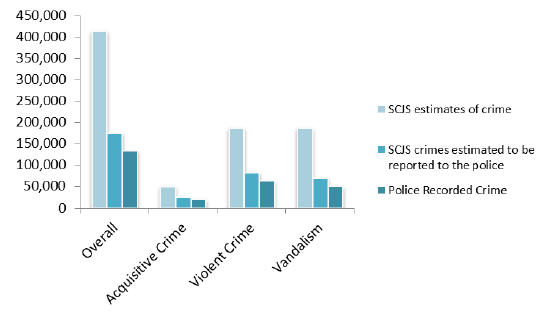
Sources: SCJS, Police recorded crime
This analysis can be extended across the comparable crime sub-groups:
- Around 25,000 (or 50%) of acquisitive crimes are estimated to have been reported to the police in 2014/15. As the police recorded 21,000 acquisitive incidents in 2014/15, using the SCJS, it is estimated that 84% of comparable acquisitive crime estimated to have been reported to the police, were recorded in police statistics.
- Around 82,000 (or 44%) of violent crimes are estimated to have been reported to the police in 2014/15. The police recorded 62,578 violent incidents in 2014/15. Therefore, it is estimated that 76% of the violent comparable crime estimated to have been reported to the police, were recorded in police statistics.
- Around 69,000 (or 37%) of vandalism incidents are estimated to have been reported to the police in 2014/15. As the police recorded 49,592 vandalism incidents in 2014/15, it is estimated that 72% of the comparable vandalism crime estimated to have been reported to the police, were recorded in police statistics.
3.5.3. Ratio of Police Recorded Crime to SCJS 'Reported' Crime
An alternative approach to investigating the relationship between the two sources is to examine the ratio of police recorded crime to the volume of SCJS crime estimated to have been reported to the police. The analytical paper, published in 2014, outlined two methods for calculating this: the first, comparing the biennial SCJS to annual recorded crime figures and the second comparing the biennial SCJS against two financial years of averaged police recorded crime data. This section updates the information using the first method, to compare the biennial SCJS to annual recorded crime figures[13].
Figure 3.7 Ratio between police recorded crime and SCJS crime estimated to have been reported to the police
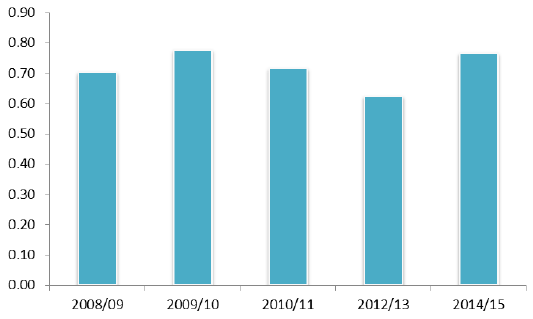
Sources: SCJS, Police recorded crime.
Figure 3.7 shows annual recorded crime figures compared to crime estimated to have been reported to the police by the SCJS (across the two-year fieldwork recall period)[14].
The ratio between police recorded crime and SCJS crime estimated to have been reported to the police peaked in 2009/10. In 2009/10, of the 630,000 crimes in the comparable category, 252,000 (40%) crimes were estimated to have been reported to the police, while also in 2009/10 the police recorded 195,728 crimes. It can therefore be estimated that around 78% of the crime estimated to have been reported to the police in the SCJS was captured in police statistics.
In 2014/15, the SCJS estimated that of the 414,000 crimes in the comparable category, around 174,000 (42%) crimes were reported to the police, while also in 2014/15 the police recorded 133,170 crimes. From this, it can be estimated that around 77% of the crime estimated to have been reported to the police in the SCJS was captured in police statistics.
By applying this method of comparison, it is notable that there is a level of variation in the resulting ratio over the five sweeps of the survey. Having increased from 70% in 2008/09 to 78% in 2009/10, the proportion of crime reported to the police then fell to 62% in 2012/13, before returning to 77% in 2014/15 (Figure 3.7).
Contact
Email: Trish Brady-Campbell
There is a problem
Thanks for your feedback